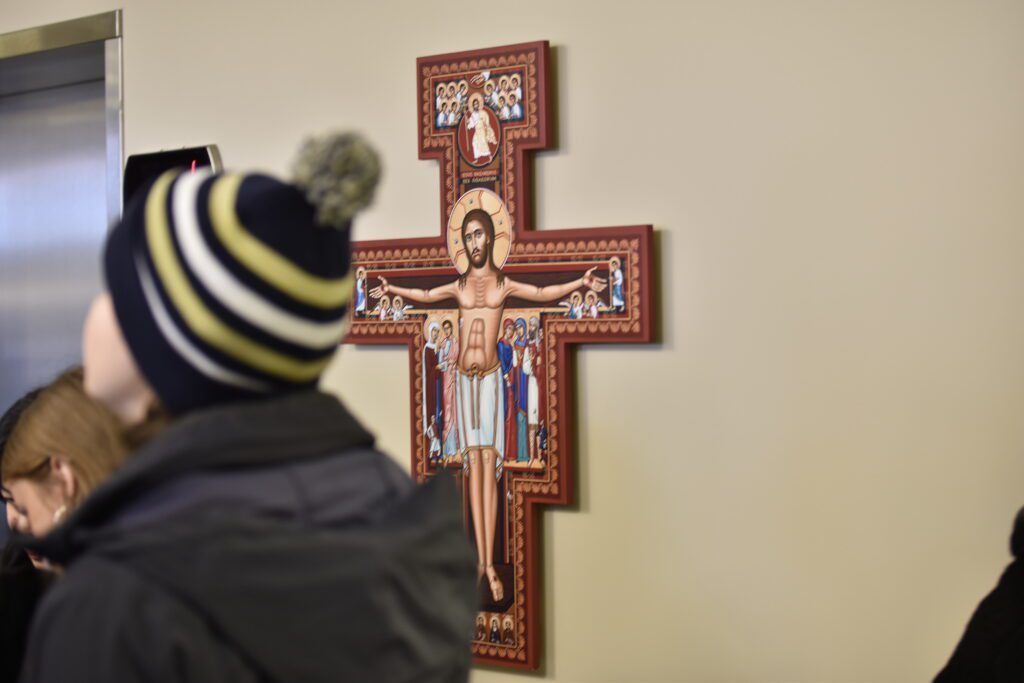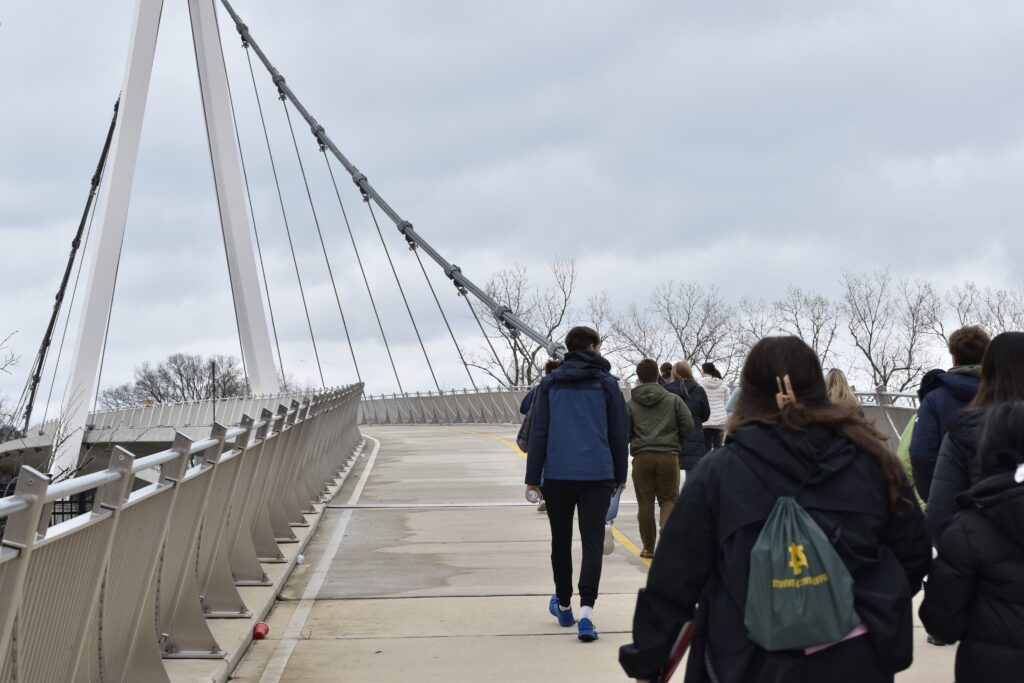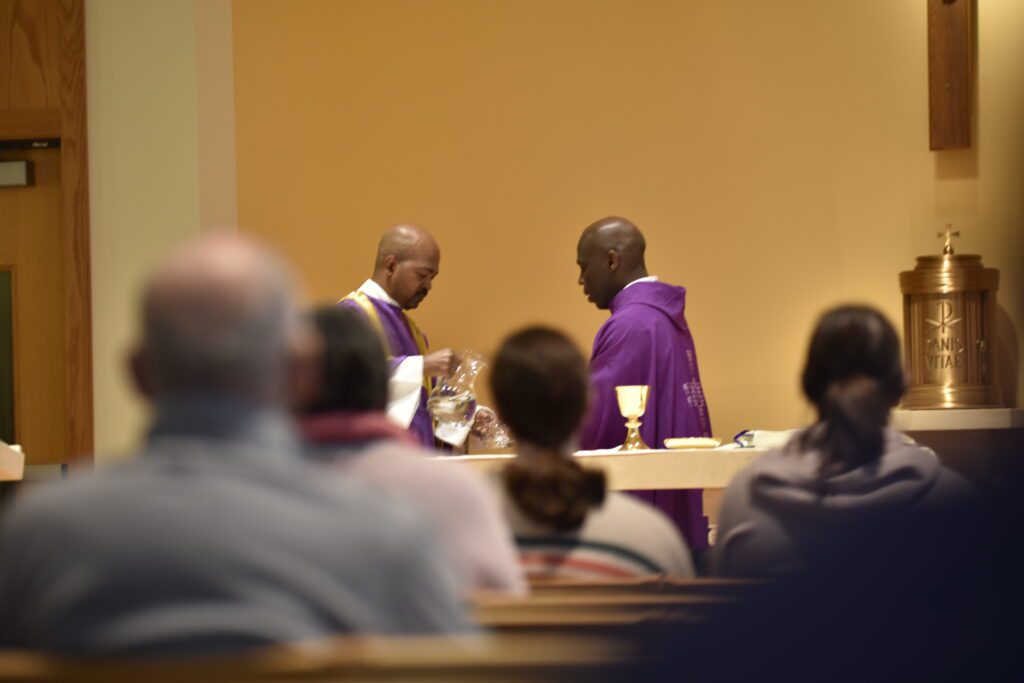Pilgrim Encounters
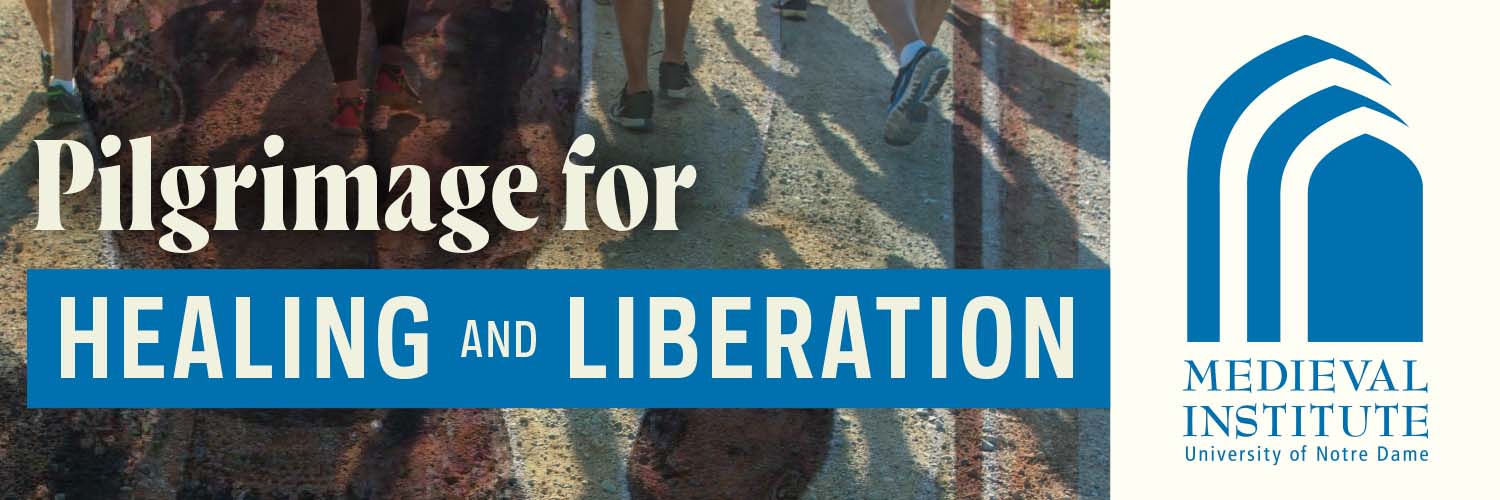
For nearly 2000 years, pilgrims have walked the Way of the Cross in Jesus’ footsteps. They recall the events of his Passion to draw close to him in his suffering. Death, though,is not the end of the story. The Holy Sepulchre marks the tomb from which Christ rose to new life, thereby liberating all creation from the power of death. What was once a place of trauma and violence has become sacred ground where compassion and freedom take root.
The destination for our pilgrimage was likewise the site of one man’s suffering and death. We walked to the bridge where Father Tolton returned by train from a priests’ retreat out of town. He began walking home in 105-degree heat but collapsed one block away from the station. Standing at the site of his collapse, we placed flowers and sang, lamenting the devastating impact of poverty, violence, and environmental racism on the people of Southside Chicago, where Tolton tended the sick and preached the Gospel.
Experience the Event
Presented by The Medieval Institute
“We may have to turn around if the wind gets too strong,” our bus driver told me. It was pelting rain on the morning of Saturday, April 1, the day of the Medieval Institute-sponsored pilgrimage to Southside Chicago. The night before, a tornado warning had hit Notre Dame, and I thought, even when traveling by modern-day motor vehicle, pilgrims must brave tempests to reach their destination.
Happily, the weather did not deter our driver, and our busload of 50 people disembarked at the Cardinal Meyer Center to walk in the footsteps of Father Augustus Tolton, the first recognizably Black American Catholic to be ordained a priest. The members of our pilgrim band, ranging in age from their teens to their eighties, hailed from Saint Mary’s College, the University of Notre Dame, Holy Cross School, and two local parishes, Saint Augustine’s and Saint Pius. We represented a cross-section of academic disciplines and communities from around South Bend.
The journey to Chicago marked the end of the MI’s Pilgrimage for Healing and Liberation series. On my mind were lessons learned from the four webinars we hosted throughout the spring semester. First, the goal of the journey is to come home changed. Pilgrimage encompasses our experience en route to holy places and within sacred precincts, but it doesn’t end there. The pilgrim identity leaves an imprint that lingers once the journey is over. Muslims who make the hajj earn an honorific title when they return home, signifying that they have grown in wisdom from their sojourn to Mecca. In the panel discussion on “Pilgrimage in the Global Middle Ages,” Professor Mun’im Sirry shared that some Indonesian Muslims even take a new name to emphasize that the hajj has changed their very identity. Of course, our day trip to Chicago was not as momentous as a once-in-a-lifetime pilgrimage to Mecca. Nevertheless, as pilgrims we set out with intentionality, desiring new energy to animate our work for racial justice.
The second lesson: how we go is as important as where we go. Professor Layla Karst, in the webinar on “Becoming a Pilgrim People,” described making a pilgrimage as a liturgical act that forms us as church. By journeying together, the pilgrim community makes God’s presence visible in the world here and now. Karst challenged those of us making the pilgrimage to become the church that the world needs today. Between 2021 and 2024, Pope Francis has invited Catholics into a synodal process designed to intensify communion, participation, and mission in the life of the church. By gathering a mix of students and community members, our group witnessed to Pope Francis’ vision for a church of encounter and dialogue between people of diverse cultures, generations, and life experiences.
The preeminent sacred site for Christian pilgrims is Jersualem, the place of Jesus’ death and resurrection. As Professor Robin Jensen explained, Christian pilgrimage dates back to the fourth century when the Church of the Holy Sepulchre was built. For nearly 2000 years, pilgrims have walked the Way of the Cross in Jesus’ footsteps. They recall the events of his Passion to draw close to him in his suffering. Death, though,is not the end of the story. The Holy Sepulchre marks the tomb from which Christ rose to new life, thereby liberating all creation from the power of death. What was once a place of trauma and violence has become sacred ground where compassion and freedom take root.
The destination for our pilgrimage was likewise the site of one man’s suffering and death. We walked to the bridge where Father Tolton returned by train from a priests’ retreat out of town. He began walking home in 105-degree heat but collapsed one block away from the station. Standing at the site of his collapse, we placed flowers and sang, lamenting the devastating impact of poverty, violence, and environmental racism on the people of Southside Chicago, where Tolton tended the sick and preached the Gospel. He died at a nearby hospital on July 9, 1897. In an American church that long denied his vocation because he was Black, Tolton persevered, shared his gifts, and made a way out of no way for Black Catholics. His life and ministry bore heroic witness to the promise of God’s Reign, where all are welcome and provided for abundantly.
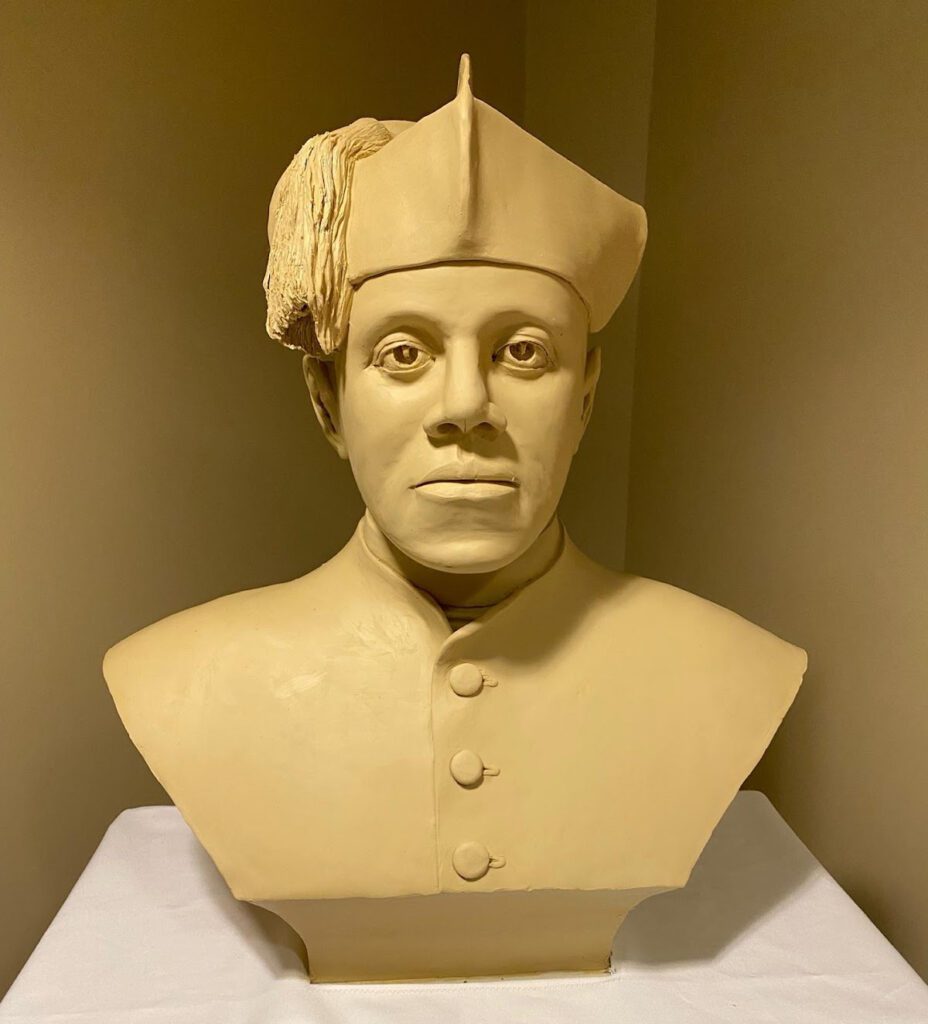
A providential surprise awaited us at the end of our journey. The founders of Warriors 4 Peace, an Indianapolis non-profit, were in Chicago the same day to meet with Bishop Perry, the promoter of Tolton’s cause. Warriors 4 Peace opposes gun violence and promotes peaceful change to honor the memory of Jack Shockley, who was murdered by handgun in 2020 when he was 24 years old. Jack’s parents adopted Fr. Tolton as the patron saint of their peace-making work, and an artist friend of theirs had created two sculptures of Tolton, which were on display the day of our pilgrimage. The life-size bust of Augustus Tolton generated a powerful sense of energy and presence. The icons reminded me of sacred art’s capacity to bring us face to face with the holy witnesses who have gone before us and still accompany us in the struggle for justice and peace.
Pilgrimages stage multiple encounters that have the potential to change people along the way. Through story, art, and places of memory, our pilgrim community encountered Fr. Tolton, a Black Catholic soon-to-be saint. We met our hosts at the Black Catholic Initiative of the Archdiocese of Chicago, who are carrying on the legacy of Tolton’s apostolate. We listened to the Shockley’s, who invited us into their grief. And throughout the day, while riding the bus and breaking bread together, each pilgrim encountered fellow travelers who had likewise given up their Saturday and defied stormy weather to make the journey. Pilgrimage both connects us with the religious practices of the deep past and forms us for a synodal church that can walk together into the future.
Pilgrimage for Healing and Liberation is sponsored by the Medieval Institute and co-sponsored by the Department of Africana Studies, the Department of Theology, Program of Liberal Studies, Cushwa Center for the Study of American Catholicism, Ansari Institute for Global Engagement with Religion, and the Notre Dame Initiative on Race and Resilience. We are so grateful that you are joining us on the way.
View EventPilgrimage and Public Humanities
Pilgrimage and the institutions that supported it spanned the many cultures and religions of the ancient and medieval worlds. It was a truly global phenomenon of the Middle Ages. Pilgrims undertook their journeys to fulfill religious obligations, to give thanks for healing, and to receive counsel from spiritual experts. Established routes led to sacred sites located on natural landmarks or along waterways, and marked by temples, shrines, churches and mosques. Often pilgrims desired contact with a sacred object, like an image of the divine, believed to possess healing power.
Going on pilgrimage still appeals today to people religiously affiliated or not, and medieval routes continue to attract travelers. Moreover, pilgrimage is now being used in justice work as an embodied practice that can support liberation and healing. What are the common threads and important differences between the practice of pilgrimage in the deep past and our present moment? Can the long history of pilgrimage inform current thinking about hospitality and encounter?
The imperative to provide hospitality catalyzed the invention of major social institutions in the Middle Ages. Hospitals and other charitable associations were established across Africa, Europe, and Asia to house pilgrims along their route and welcome them at their destination. On pilgrimage, medieval people encountered different cultures, and a rich literature developed as writers published accounts of their travels. Ibn Battuta, a Muslim jurist from Morocco, devotes much of his famous travel narrative to recounting visits with Sufi saints and Islamic scholars; as he made the obligatory pilgrimage to Mecca in 1325, he sought out their learning and their blessing. Similarly, the English Christian merchant and author Margery Kempe emphasizes the positive relationships she fostered while on pilgrimage to Jerusalem and Rome in 1413. She finds help and support from Muslim tour guides who comfort her, a German priest who hears her confession, and wealthy Italian women who provide for her when she embraces voluntary poverty. Pilgrimage, for these writers, was as much about the journey as the destination.
The Medieval Institute’s public humanities initiative for Spring 2023 will investigate pilgrimage as a global medieval phenomenon structured by practices of hospitality and cross-cultural encounter. Our “Pilgrimage for Healing and Liberation” will, first, educate the public about the history, theology and liberatory praxis of pilgrimage and, second, sponsor two pilgrimage experiences. These events will help all who participate to understand how histories of violence and inequity have shaped our local environment in South Bend and to imagine how we might create a more just and inclusive community through systemic transformation. The participatory nature of pilgrimage lends itself to the work of public humanities as we partner with community organizations to “learn by doing.”
Beginning in January and continuing through March 2023, a series of webinars will present innovative research on cross-cultural approaches to studying the deep past as well as liberation theology and the arts. The first, “Pilgrimage in the Global Middle Ages: Hospitality and Encounter,” will compare medieval pilgrimage practices across the Judeo-Christian, Islamic and Chinese Buddhist traditions to explore commonalities and differences, with particular attention to the themes of hospitality and encounter. The second, “Pilgrimage and the Praxis of Liberation,” will examine theologies of pilgrimage and racial reconciliation. The third, “Sacred Art and the Journey toward Justice,” featuring artist Kelly Latimore, will consider images of the holy encountered at pilgrimage destinations with a focus on Black/Brown iconography in the Christian tradition. Finally, “The Black Madonna for Racial Liberation: A Spirituality to Empower Sacred Activism” will feature Dr. Christena Cleveland, author of God Is a Black Woman, which tells of her pilgrimage to France to see Black Madonna statues. Dr. Cleveland’s public theology models how pilgrimage and story-telling can serve the work for racial equity.
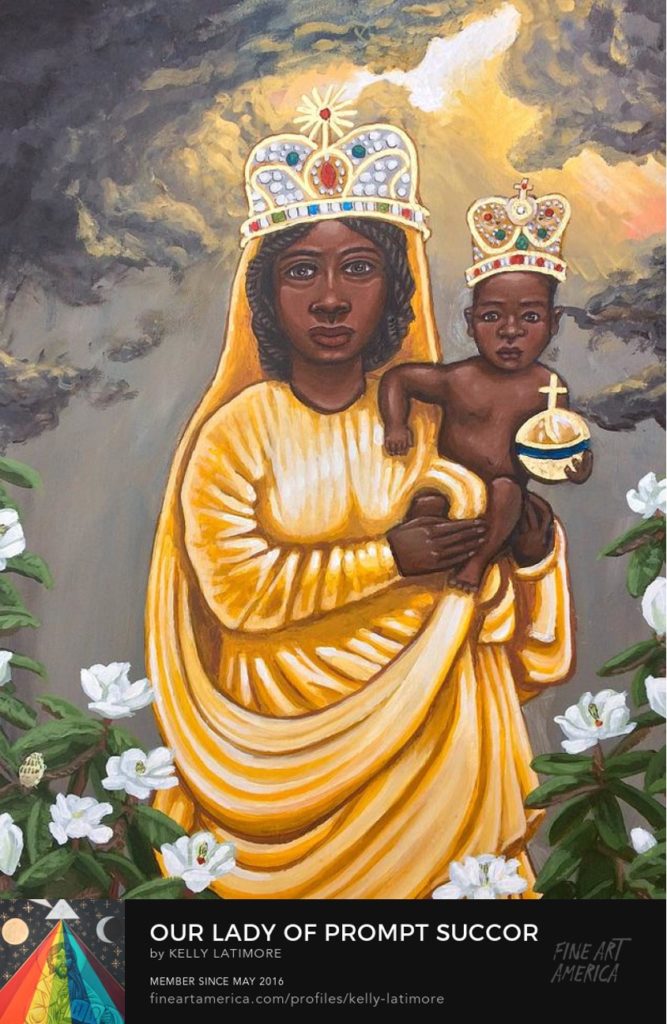

This learning will prepare us to embark on two in-person pilgrimages in April 2023. One will take place in Chicago, where we will visit sites connected to Father Augustus Tolton, the first self-identified African-American man to be ordained a Catholic priest. He is currently one of the six African-American candidates for sainthood. By walking in his footsteps and visiting the site where he died, we will remember Tolton’s witness to the Gospel and his perseverance within the church despite its endemic racism. He strove to realize the church’s mission to be “truly Catholic” and inclusive of all people.
For the second pilgrimage experience, participants will walk through the city of South Bend to landmarks from local African-American and Civil Rights history. We are partnering on this event with the local chapter of Faith in Indiana, a non-profit organization that mobilizes faith leaders to work for racial and economic equity. The goal is to raise consciousness and foster conversation around issues such as access to housing, health care, education, employment, and capital. Along the way, we will hear from speakers immediately impacted by structural violence, make connections between the landmark sites and current issues in local politics, and imagine the kind of community we want to live in – one that is inclusive, equitable and just.
This article was written by Annie Killian, Ph.D,, Public Humanities Postdoctoral Fellow of the Medieval Institute at the University of Notre Dame, and published on the Medieval Institute website on November 30, 2022.
Pilgrim Encounters: A Visual Journal
